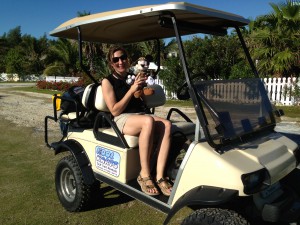BAHAMAS PIPING PLOVER PROJECT
WINTERING PIPING PLOVER SURVEYS ON ABACO
By Todd Pover, Beach Nesting Bird Project Manager and Stephanie Egger, Wildlife Biologist

An integral part of this Bahamas trip entailed surveying several sites not previous covered on Abaco and revisiting some sites not checked since the 2011 International Piping Plover Census. Although we didn’t find large concentrations of piping plovers at any one new site, we did make some noteworthy discoveries.
One of the most exciting find was the resight of a piping plover that was banded on the breeding grounds last summer in Massachusetts as part of a flight behavior study. New Jersey also participated in this research and we briefly thought it might be one of the birds banded in our home state – but it turned out that it was banded (and nested) on Chapin Beach, Cape Cod and is wintering at Schooner Bay, Abaco (amongst 15 other piping plovers found on our survey).

We continue to assess what specific habitat types are preferred by piping plovers in the Bahamas and during which tidal cycles. The oceanfront site (Island Homes/Long Beach) where we had seen ~50 plovers at high/mid tide on a previous visit had no plovers at low tide this time around. This type of information is especially important to better direct when and where surveys should be conducted during the next International Census – hopefully resulting in more accurate and comprehensive survey results.
Because of ferry schedules (and the high cost of lodging), our time on Green Turtle Cay had previously always been limited to short day visits. On this trip we stayed overnight which provided us more time to survey the oceanfront beaches for the first time. It also allowed us sufficient time to survey the Gillam Bay sand flat at different tides. Unlike most other sites that are used either as a roost (resting) or foraging (feeding) location at high and low tide, respectively, we observed the birds during the entire cycle and were able to determine that at this site they move directly off the roost to begin foraging as soon as the tide starts to go out. Although only a modest number of piping plovers use the site, its use for all tide cycles increases its importance. Furthermore, a large number and variety of other shorebirds and wading birds use this flat. Given what we know, the Green Turtle Cay flat appears to be especially important for Abaco and we believe it warrants some conservation consideration.

We finally made it to the extreme southern end of Abaco – Sandy Point – to conduct surveys. We were able to hire a conchfisherman on the spot at the dock to take us out at low tide. Unfortunately, we didn’t locate any piping plovers – there is just a narrow peak low tide window to cover these vast flats. Furthermore, not all flats are “created equal” when it comes to piping plovers. Many of the tidal flats in this area are covered by a heavy layer of sea grass at low tide; not preferred by piping plovers although other shorebirds were present. Sandy Point needs another visit as not all the ground was covered and we know from local birders that some pipers use the flats.
Last but not least, we finally got into the Cross Harbour area in southern Abaco, which involved nearly an hour drive through the pine forests on a “challenging” dirt roadway to access. From there it was several hours of kayaking and walking to complete a survey. (Thanks to Schooner Bay and Glen Kelly for making this possible!) Conservation of this area has already been identified as a high priority based on its critical role for aquatic species; as a nursery and highly productive marine environment. Of particular importance is the wetland mangrove habitat, which we were fortunate enough to paddle through. Only a handful of piping plovers were found, but it is clear how important Cross Harbour is overall for a wide variety of species. I (Todd) observed the most live conch in the exposed grass beds I have ever seen in one place, not to mention the most sea turtles. Piping plovers aside, it was a spectacular site by any measure!
NOTE: We would especially like to thank our “volunteer” partners on this trip; Annette Scherer, Karen Terwilliger, Alfredo Alvarez, and Haydee Salgado. We couldn’t have covered as much ground without them!
Discover more from Conserve Wildlife Foundation of NJ
Subscribe to get the latest posts sent to your email.
Leave a Comment
Way to go Steph! Keep up the great work! Love reading your blogs!
Comments are closed.